
What's on this page
Hyundai Kona 2023
This is what James Cleary liked most about this particular version of the Hyundai Kona: Refinement, Equipment, Practicality
The 2023 Hyundai Kona carries a braked towing capacity of up to 1600 Kg, but check to ensure this applies to the configuration you're considering.
The Hyundai Kona is also known as the Hyundai Kauai (Portugal) and the Hyundai Encino (China) in markets outside Australia.
Hyundai Kona 2023 News
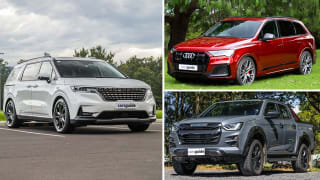
Emily Agar's top 5 cars of 2023: Isuzu D-Max to BMW X6 and everything in between

Australia's new hybrid car king? Hyundai i30, Kona, Tucson and Santa Fe hybrids to take on everything from the RAV4 to the Corolla Cross
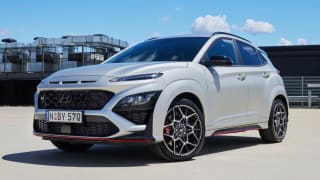
ExtiNction event! Last call on Hyundai Kona N performance SUV as Hyundai looks towards electric car future
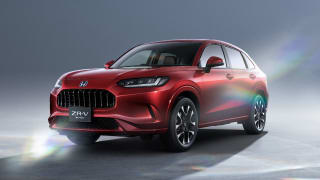
Best small SUVs and crossovers arriving in 2023
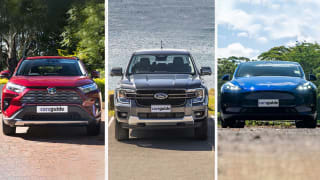
New car delivery update: Can you have the Toyota RAV4, Ford Ranger or Tesla Model Y you want today or will you have to wait? If so, how long?
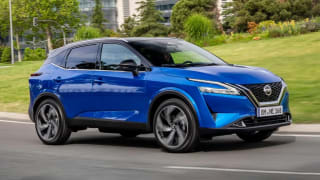
Best hybrid cars arriving in 2023

What is Australia's best selling small SUV? 2023 MG ZS and GWM Haval Jolion take on Japanese and Korean rivals like Kia Seltos, Mazda CX-30 and more
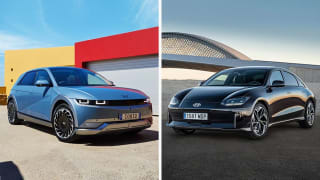
Hyundai is crushing it with its new designs, even more than Kia and Genesis | Opinion

Target Toyota: Japanese giant on notice as Hyundai vows to go hard on hybrids in Australia
Hyundai Kona 2023 Price and Specs
Pricing guides

| Hyundai Kona Model | Body Type | Specs | Price from | Price to | |
|---|---|---|---|---|---|
| (FWD) | SUV | 2.0L ULP CVT AUTO | $25,410 | $31,350 | |
| Active (fwd) | SUV | 2.0L ULP CVT AUTO | $27,610 | $33,220 | |
| (base) | SUV | 2.0L — CVT AUTO | $28,600 | $34,430 | |
| Electric EXT Range | SUV | — Electric 1 SP AUTO | $54,230 | $62,370 | |
Hyundai Kona 2023 Interior
Inside the look is clean and geometric with a two-level dash treatment dominated by the sizeable central multimedia screen, with twin displays creating a sleek, driver-focused digital band across more than half the car’s width.
On all 1.6-litre Turbo models and Kona Premium grades a shift-by-wire gear selector has been relocated from the centre console to a stalk behind the steering wheel, a la Ioniq 6 freeing up space in the centre console, which we’ll get to when looking at practicality, shortly.
As well as a more aggressive exterior the N Line Pack adds a sporty vibe inside with dark brushed alloy-effect elements around the cabin as well as gloss red inserts, red highlights and contrast stitching on the Alcantara and leather-trimmed seats, plus alloy pedal covers and perforated leather grips on the steering wheel.
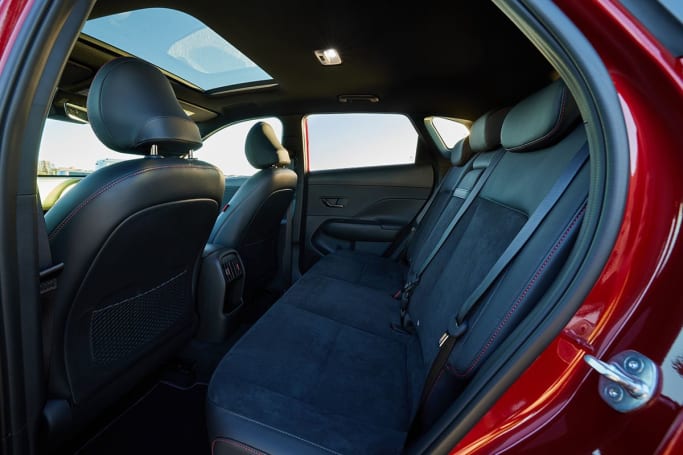
Hyundai Kona 2023 Colours
- Atlas White
- Ecotronic Grey
- Ultimate Red
- Mirage Green
- Denim Blue
- Abyss Black
- Cyber Grey
- Neoteric Yellow
- Soultronic Orange
Hyundai Kona 2023 Boot Space
Hyundai claims improved cargo volume of 407 litres (VDA) with all seats up and 1241L with the 60/40 split-folding second row lowered… up appreciably on the first-gen model. A hands-free power tailgate is standard on the Kona Premium, the loading lip is agreeably low and the spare is a 16-inch space saver.
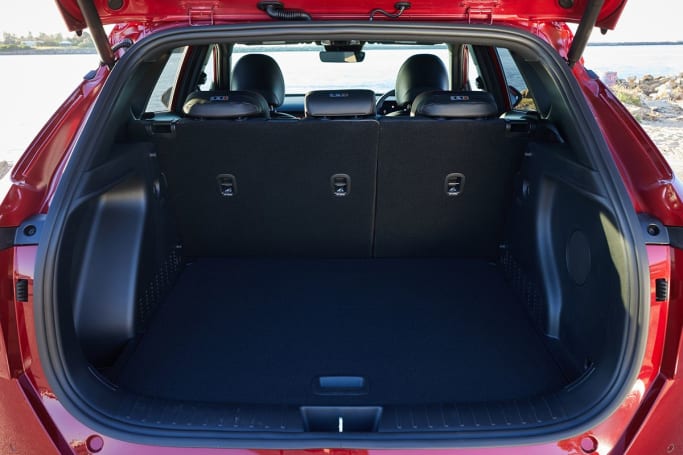
Hyundai Kona 2023 Dimensions
Dimensions for the 2023 Hyundai Kona are dependent on which body type is chosen. The maximum width and height is 1825mm x 1590mm and can vary on the basis of model.

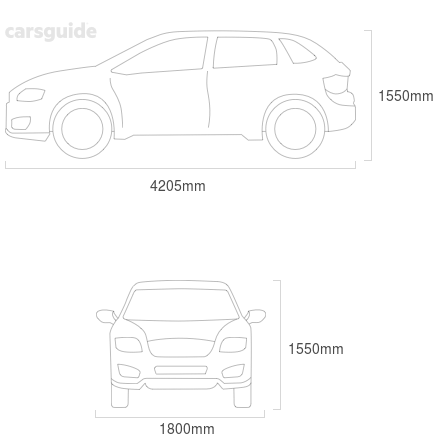
| Hyundai Kona Model | Body Type | Height x Width x Length | Ground Clearance | |
|---|---|---|---|---|
| (FWD) | SUV | 1550x1800x4205 mm | 170 mm | |
| Active (fwd) | SUV | 1550x1800x4205 mm | 177 mm | |
| Elite (fwd) | SUV | 1550x1800x4205 mm | 177 mm | |
| base | SUV | 1585x1825x4350 mm | 170 mm | |
Hyundai Kona 2023 Accessories
Standard equipment highlights for the Kona include dual-zone climate control air, a 12.3-inch multimedia touchscreen, six-speaker audio with digital radio, Android Auto and Apple CarPlay connectivity, cloth seats, a leather-appointed steering wheel, a 4.2-inch display in the instrument cluster, four-sensor parking distance warning, 18-inch alloys, keyless entry and start as well LED headlights, DRLs and tail-lights.
The Kona Premium adds a 12.3-inch digital instrument display, eight-speaker Bose audio, ambient lighting, heated, ventilated and power-adjustable front seats and heated outboard rear seats, sat nav, a 3D surround view monitor, six-sensor parking distance warning, ‘Remote Smart Parking Assist’, voice control and partial leather trim.
The N Line pack brings body-coloured cladding and other specific exterior elements including the front bumper (with gloss black insert), side skirts, spoiler, rear bumper and gloss black mirror caps. Also included are unique 19-inch alloy rims, a sports exhaust, dual projector beam headlights and interior upgrades include, dark brushed alloy-effect elements around the cabin as well as gloss red inserts, red highlights and contrast stitching on the Alcantara and leather-trimmed seats, plus alloy pedal covers and perforated leather grips on the steering wheel.
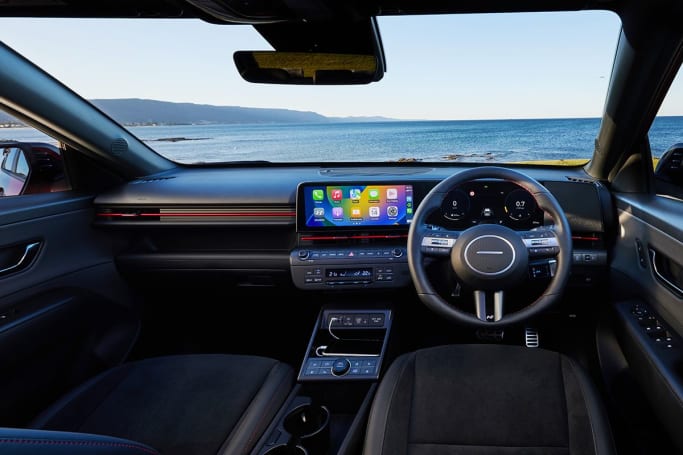
Hyundai Kona 2023 Q&As
Check out real-world situations relating to the Hyundai Kona here, particularly what our experts have to say about them.
-
Should I buy a 2024 Hyundai Kona Hybrid or a Kia Seltos Sport+?
CarsGuide tested the Kona Hybrid late last year (you can check out the review and video here) and came to exactly the same conclusion: That the car was great around the city, but lacked a bit of overtaking oomph at highway speeds.
This will not be a problem for many owners who will possibly never need to overtake on a country road, but for those who do, perhaps there are better choices out there.
Your comparison with the petrol Captiva is a valid one, too. On paper, this car had plenty of urge, but the power was all stacked way up in the higher rev ranges and required some forward planning when overtaking.
Show more -
Should I buy a Mazda CX-3 or Kona Elite from 2020?
Early this year, Hyundai issued a recall for some Konas built between 2020 and 2022 to deal with problems with the eight-speed dual-clutch transmission which could cause a loss of drive and, therefore, a dangerous situation on the road. So the first check would be to see if your car you're looking at is affected by that recall (a Hyundai dealer will be able to tell you by looking up the car's VIN). If the car is one of the affected ones but the recall's fixes have been applied, then you have less to worry about.
The Kona's engine problems, meanwhile, were another cause for a safety recall after it was discovered that a batch of Konas had defective piston rings which could cause early engine wear and possibly even a fire. Again, these problems were being fixed by Hyundai, but you need to check whether the example you're looking at buying was one of the affected ones and what's been done about it by the previous owner.
The Mazda CX-3 of the same era has not been without its recalls either, including one for a suspension joint that could fail, but overall, the experience of owners suggests the Mazda could be the less risky bet. Again, though, check the service and recall history of any car before handing over the money.
Show more -
My 2018 Kona Active steering wheel is making noises when turning or when I come to a stop.
The best guess is that the noise is being generated by the electric motor integrated into the steering column that acts as the power-steering in the Kona. If it’s s faint noise that is heard more often with the windows closed and the stereo off, then it’s the same noise that other Kona owners have noted.
Another possibility is a noisy clock-spring. This is a flexible electrical contact inside the top of the steering column that allows the steering wheel to turn while still maintaining all the electrical contacts that power the air-bags and steering wheel-mounted controls. These clock springs often become noisy just before they fail.
Your car is still under warranty, and since you’ve already logged the fault with your Hyundai dealer, it’s now a pre-existing problem and must be fixed by Hyundai, even if the car itself runs out of warranty in the meantime.
Show more -
How do I tell if a 2019 Hyundai Kona is AWD or FWD?
It’s pretty simple, James, and despite both two and four-wheel-drive being offered on all trim levels of the Kona, there’s one thing to check that will answer your question: If the vehicle has the two-litre, non-turbocharged engine, it’s a two (front) wheel-drive. If it has the 1.6-litre turbocharged engine, it’s an all-wheel-drive Kona. Hyundai never offered a front-wheel-drive Kona with the turbo engine, nor all-wheel-drive with the non-turbo.
Beyond that, there were some other major technical differences that will also tell you what you’re looking at. The front-drive Kona has a simpler, torsion-beam rear suspension, while the AWD version has a multi-link arrangement. Then there’s the transmission. Front-drive Konas got a six-speed conventional automatic, while the AWD Kona got a dual-clutch seven-speed transmission.
Show more
Hyundai Kona 2023 Fuel consumption
Fuel consumption for the 2023 Hyundai Kona is dependent on the type of engine, transmission, or model chosen. The Hyundai Kona is available with the following fuel types: —, Electric, PULP and ULP.
| Hyundai Kona Model | Body Type | Specs | Fuel Consumption | |
|---|---|---|---|---|
| base | SUV | 2.0L,—,CVT AUTO | 6.6L/100km | |
| Electric EXT Range | SUV | Electric,1 SP AUTO | — | |
| N | SUV | 2.0L,PULP,8 SP AUTO | 9L/100km | |
| (FWD) | SUV | 2.0L,ULP,CVT AUTO | 6.2L/100km | |
Hyundai Kona 2023 Towing capacity
The Hyundai Kona’s towing capacity ranges from 0kg to 1600kg. Some models also offer heavy-duty or towing option packs which can increase towing capacity, as well as options which can hamper towing capacity. Towing capacities can vary wildly on a large number of factors. These include engine, transmission, model, and options chosen. Always check with the manufacturer or in your vehicles handbook before attempting to tow anything.
| Hyundai Kona Model | Body Type | Specs | Braked Capacity | |
|---|---|---|---|---|
| (FWD) | SUV | 2.0L,ULP,CVT AUTO | 1300kg | |
| Active (fwd) | SUV | 2.0L,ULP,CVT AUTO | 1300kg | |
| Elite (fwd) | SUV | 2.0L,ULP,CVT AUTO | 1300kg | |
| base | SUV | 2.0L,—,CVT AUTO | 1300kg | |
Hyundai Kona 2023 Engine
The Kona and Kona Premium are offered with a naturally aspirated Atkinson-cycle 2.0-litre four-cylinder petrol engine sending 110kW/180Nm to the front wheels through a CVT auto. Then, a 1.6-litre turbo-petrol engine pushing 142kW/264Nm to all four wheels via an eight-speed (torque converter) auto is in two N Line-only models across Kona and Kona Premium grades.
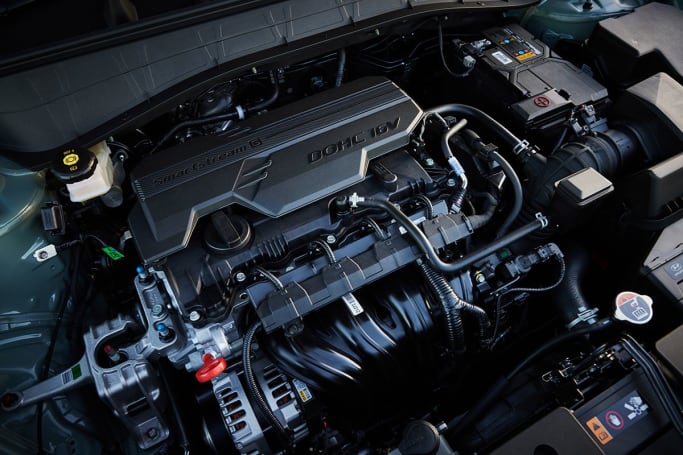
Hyundai Kona 2023 Range
The entry 2.0L petrol and 1.6L turbo-petrol engines run happily on 91 RON ‘standard’ unleaded, or E10, and the Kona fuel tank holds 47 litres, which translates to a range of just over 700km for the atmo engine and around 600km for the turbo.
Hyundai Kona 2023 Wheel size
Wheel size for the 2023 Hyundai Kona will vary depending on model chosen, although keep in mind that many manufacturers offer alternate wheel sizes as options on many models.The wheel size available will alter the range of tyres available to be fitted.
| Hyundai Kona Model | Body Type | Front Tyre Size | Front Rim | Rear Tyre Size | Rear Rim | |
|---|---|---|---|---|---|---|
| (FWD) | SUV | 205x60 R16 9 | — | 205x60 R16 9 | — | |
| Active (fwd) | SUV | 215x55 R17 9 | — | 215x55 R17 9 | — | |
| Elite (fwd) | SUV | 215x55 R17 9 | — | 215x55 R17 9 | — | |
| base | SUV | 215x55 R18 9 | — | 215x55 R18 9 | — | |
Hyundai Kona 2023 Seats
The Kona is a five-seater and the front seats, from the entry car up, are impressively comfortable and supportive even after long stints behind the wheel. The entry Kona’s seats are cloth-trimmed with the Kona Premium stepping up to partial leather and the N Line bringing Alcantara and leather-trimmed seats.

Hyundai Kona 2023 Speed
Expect the 2.0L Kona to accelerate from 0-100km/h in around 8.5 seconds with a top-speed of 195km/h, with the 1.6L turbo lowering that 0-100 time to approximately 7.5 seconds, with a top-speed of 205km/h.



